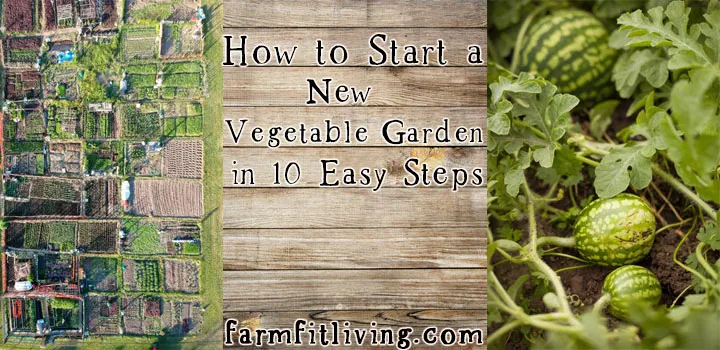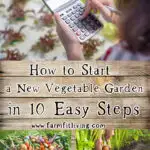Want to start a new vegetable garden but don’t know where to begin?
Learning how start a new vegetable garden is much easier than you might think. Sometimes it just takes time.
If you’re completely new to gardening and/or starting a new garden from scratch, this is a good place for you to start. I’ve been a gardener since I was old enough to toddle around in the dirt. My mom would give me old seed to plant and then show me what came up.
These memories make me so happy to this day. I want you to make these memories in your garden, too. I can best describe gardening as having a great caring relationship with your plants. Your garden will need lots of TLC and nurturing from you.
In this post, I will:
- Share how to start a new vegetable garden in just 10 easy steps.
- Teach you to choose the best spot for your garden and plan a successful garden wherever you are.
- Explain the Step by Step process to successful gardening.
Like I explained with any relationship, the gardening process is trial and error. You’ll make mistakes in your relationship with your garden, but you can learn from them. Remember to keep it fun and enjoy the process.
I hope you learn mostly that gardening should be relaxing and a great experience. Let’s dig into the steps.
Listen to the Podcast Episode:
This post contains Affiliate Links. This means if you click and buy, I might make a commission at no cost to you.
See my policy for more information

1. Do Your Research
If you’re completely new to gardening, you want to start here. Learn all you can about gardening BEFORE you actually plant anything. I’m here to help.
What to start with? Well, you want to think about what kind of gardener you want to be. If you’re not a fan of weeding or being out in the sun for long periods, you might be interested in learning about low maintenance gardening.
If you don’t have the space or physical capabilities, you might be interested in learning about container gardening, straw bale gardening or raised bed gardening.
The possibilities are endless. And there’s lots of resources for you to learn from. I am just one resource out of thousands or maybe even millions! Here’s a shortlist of some that might interest you as you learn to start a new vegetable garden:
- Youtube
- Sunset Western Garden Book
- Smart Gardening Made Simple
- Local Extension Office or Garden Club
- Neighbors
- Library
Finally, know that this process is a big experiment to see what works and what you like to do. It’s best to become inspired by what’s out there and what sparks your interest.
From here, you can start to put things into place.
2. Assemble Your Tools
You’ll be digging and planting in no time. First of all, you need to make a list of what you need:
This is a very short list of garden tools that are essential for beginning gardeners. I do have a longer list of tools you’ll need as you advance in your gardening journey.
Go here for a list of must-have garden tools
3. Start Small
Don’t bite off more than you can chew. Don’t plant more than you can care for.
Start small and grow as you learn. You might figure out you don’t even like gardening. Plan ahead. Gardening is a process and it takes time to figure out what works best.
I suggest a small area of 10×10 or a square raised bed to test out what could go right or wrong. Take time to learn and enjoy this experience.
4. Prepare Your Soil
This is the most important step. You need to figure out if your soil can even grow plants. You need to get the soil bed right before you tuck the seeds in.
Good soil is the foundation of any garden. The pH should be about 5.5-6.5 and there should be a proper amount of Nitrogen (N), Phosphorus (P) and Potassium (K). How can you find this information out?
Well, you need to take a soil test. Go here to learn this process of taking a soil test.
Once your soil test lab results are returned to you, you can analyze if you need to amend your soil to fit the requirements for pH, N, P, and K. You also need to keep water drainage in mind. Note that clay soils hold water longer than sandy soils.
This information is so important to know as you decide what to plant in your garden spot. Note: If you are doing raised beds or container gardens with potting soil, you can skip the soil test.
I like preparing my soil for planting in the fall. This allows me to clean up from the season and to give nutrients plenty of time to soak into the garden. Read more about that here.
5. Decide What You Want To Plant
Here’s the fun part of planning. What are you going to plant? Should you plant seeds or plants?
The main thing you should do is make sure you grow what YOU like to eat. Grow what you can use and what you don’t mind having a lot of. Grow what you can preserve for later.
Because, chances are, you’ll have beginner’s luck and have a huge yield of whatever you choose to plant. If you don’t love eggplant, just grow a few plants or don’t grow any. Make a list of these veggies you love and focus on them.
Also, you want to make sure whatever you grow will fit in with your environment. What zone do you live in? What is your soil like? How much space do you have? Will one certain vegetable grow well next to another?
Take your time deciding what you want to plant because you could lose money buying the wrong plants for these considerations. But also, don’t be too hard on yourself if you do fail some. The planning is not over yet.
6. Plan Out Your Growing Season
You can plan out your entire growing season from spring to fall and even longer if you want. Here’s some things to consider as you continue planning out your season:
- The sun shifts as the seasons change so watch how the sun hits different areas of your yard.
- Read and research plant tags and seed packets.
- Pay special attention to height and width of plants at maturity.
- Figure out which plants like full sun or partial shade.
- Will you be available through the season to care for your plants? Take account of any vacations or trips you might take.
As you’re planning out your garden season, also make a garden budget to help you plan financially for any plants, seeds or other items you might need.
7. Get Plants and Seeds
Here’s the next fun part! Shopping for plants and seeds!
Be sure to choose plants and seed varieties for your location. That shouldn’t be an issue if you’re shopping your local garden store. It is something you will have to pay more attention to if you order seeds and start your own plants.
As you’re shopping, read the tags on the plant containers or seed packets. Check for hardiness and make sure this certain variety will work for your environment. Talk with neighbors or local garden friends if you need to.
Have fun and enjoy!
8. Plant Your Garden
It’s time to get to work. Once you’ve found the plants and seeds that work best for your area and your soil is ready, you’re ready to plant.
When planting plants, dig holes about twice the size of the pot you’re planting from. Place the root ball in and cover with soil. You can add in compost to the hole if you have it available.
With seeds, I like to work the soil until it’s nice and fluffy. Then, measure out distance with my tape measure and gently push the seed into the ground.
Remember to mark your rows and plants if you have different varieties so that you know what the plants are later. Get garden markers here.
When everything is planted, water completely. Then, it’s all you caring for your seedlings and plants until it bears veggies and is ready for harvest.
9. Care for Your Garden Until Harvest Is Done
This is the part that gets hard. The waiting game.
Please remember that patience is key here. As the plants grow, you’ll need to scout for weeds, insects and disease. This is definitely the most valuable learning process you can go through. Sometimes it isn’t pretty but it’s important.
You’re going to learn so much. Remember that less is more when it comes to watering. Mulch is great for weeds. I like using straw and black plastic for mulch.
Some varieties may also need to be fertilized. Go here to learn more about fertilizing vegetable gardens.
If you are patient and care for your plants as they grow, you will have a great yield at the end for you to harvest. Keep taking care of your garden until the harvest is over. Enjoy!
10. Enjoy The Process
The process of growing a garden is like a relationship, right? It’s a miracle of planting a seed and watching it grow.
Please know and understand that there are things you won’t be able to control. The weather and environment cannot always be controlled. You’ll make mistakes that you can grow and learn from. Improve from these and move on to next year.
The best advice I’ve ever received about growing a garden is this:
- Be patient.
- Do not get discouraged. Learn from your mistakes.
If you can get through the early years of this new garden, you will be well on your way to great things.

Just Start
Another great piece of advice. Just go for it.
You’ll never know what you’re missing out in if you don’t try. You have to start somewhere and now is the time. Something brought you to this post to help you learn the 10 steps for how to start a new vegetable garden. It’s a lot of work but the benefits are great.
Gardening is so rewarding. There’s a lot to learn but even more to gain. It’s planting a seed or plant and watching it turn into food for you and your family.
Learn all you can but most importantly, take action. Start small, make a plan and just do it. Be ok with trial and error through your gardening journey. You have so much to learn. You’ll be so glad you did.
I hope this has helped you to start a new vegetable garden! Happy Gardening!


How Deep to Plant Seeds???
Get a super easy to use planting depth chart for growing the best transplants indoors from seed. Just enter your email and you'll get the guide right in your inbox.


